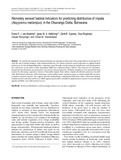| dc.contributor.author | van Bommel, Frans P. J. | |
| dc.contributor.author | Heitkonig, Ignas M. A. | |
| dc.contributor.author | Epema, Gerrit F. | |
| dc.contributor.author | Ringrose, Sue | |
| dc.contributor.author | Bonyongo, Casper | |
| dc.contributor.author | Veenendaal, Elmar M. | |
| dc.date.accessioned | 2014-04-10T11:52:52Z | |
| dc.date.available | 2014-04-10T11:52:52Z | |
| dc.date.issued | 2006 | |
| dc.identifier.citation | van Bommel, Frans P. J. et al. (2006) Remotely sensed habitat indicators for predicting distribution of impala (Aepyceros melampus) in the Okavango Delta, Botswana, Journal of Tropical Ecology, vol. 22 p.101-110 | en_US |
| dc.identifier.uri | http://hdl.handle.net/10311/1203 | |
| dc.description.abstract | We studied the spatial and temporal habitat use of impala in Botswana’s Okavango Delta at landscape level with the aid of satellite imagery, with minimal fieldwork. We related remotely sensed vegetation to impala habitat preferences, by first distinguishing three vegetation types through a multi-temporal classification, and dividing these into subclasses on the basis of their Normalized Difference Vegetation Index (NDVI). This indicator for abundance and greenness of biomass was assessed for wet and dry season separately. Similarly, habitat use was assessed for both seasons by allocating vegetation classes to bimonthly impala observations. Impala distribution patterns coincided with NDVI-based subclasses of the landscape, nested within broad vegetation types, to which impala did not show a marked seasonal response. We suggest that this methodology, using limited field data, offers a functional habitat classification for sedentary herbivores,which appears particularly valuable for application in extensive areas with high spatial variability, but with restricted access. | en_US |
| dc.language.iso | en | en_US |
| dc.publisher | Cambridge University Press, www.cambridge.org | en_US |
| dc.subject | herbivore distribution | en_US |
| dc.subject | Resource use | en_US |
| dc.subject | Remote sensing | en_US |
| dc.subject | Savanna | en_US |
| dc.subject | Ungulates | en_US |
| dc.title | Remotely sensed habitat indicators for predicting distribution of impala (Aepyceros melampus) in the Okavango Delta, Botswana | en_US |
| dc.type | Published Article | en_US |
| dc.link | http://journals.cambridge.org/download.php?file=%2FTRO%2FTRO22_01%2FS0266467405002932a.pdf&code=062762e67593a5efd298f403f4d38dc7 | en_US |

